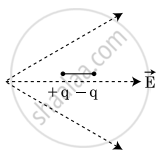Advertisements
Advertisements
प्रश्न
Arrangement of an oxygen ion and two hydrogen ions in a water molecule is shown in figure below.
Calculate electric dipole moment of water molecule. Express your answer in terms of e (charge on hydrogen ion), l and θ.

उत्तर
P1 = P2 = e × l
P = 2p cos α
= 2 e × l cos `(θ/2)`
APPEARS IN
संबंधित प्रश्न
An electric dipole of dipole moment`vecp` consists of point charges +q and −q separated by a distance 2a apart. Deduce the expression for the electric field `vecE` due to the dipole at a distance x from the centre of the dipole on its axial line in terms of the dipole moment `vecp`. Hence show that in the limit x>> a, `vecE->2vecp"/"(4piepsilon_0x^3)`
(a) Define torque acting on a dipole of dipole moment \[\vec{p}\] placed in a uniform electric field \[\vec{E}\] Express it in the vector from and point out the direction along which it acts.
(c) What would happen if the external field
An electric dipole is placed in an electric field generated by a point charge.
Two particles A and B, of opposite charges 2.0 × 10−6 C and −2.0 × 10−6 C, are placed at a separation of 1.0 cm. Two particles A and B, of opposite charges 2.0 × 10−6 C and −2.0 × 10−6 C, are placed at a separation of 1.0 cm.
Answer the following question.
Derive an expression for the electric field at any point on the equatorial line of an electric dipole.
An electric dipole is placed at an angle of 30° with an electric field intensity of 2 × 105 N/C. It experiences a torque equal to 4 Nm. The charge on the dipole, if the dipole length is 2 cm, is ______.
On the axis and on the equator of an electric dipole for all points ____________.
A conic surface is placed in a uniform electric field E as shown in the figure such that the field is perpendicular to the surface on the side AB. The base of the cone is of radius R, and the height of the cone is h. The angle of the cone is θ.

Find the magnitude of the flux that enters the cone's curved surface from the left side. Do not count the outgoing flux (θ < 45°)
The electric intensity due to a dipole of length 10 cm and having a charge of 500 µC, at a point on the axis at a distance 20 cm from one of the charges in air, is:
A dipole is placed in an electric field as shown. In which direction will it move?

